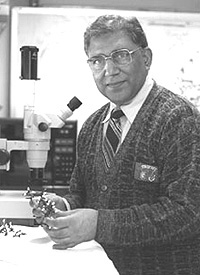Our Science – Qasba Website
Pradman K. Qasba, Ph.D.
 |
|
|||||||||||||||||||||||||||
Biography
Dr. Qasba is the chief of the Structural Glycobiology Section in the Laboratory of Experimental and Computational Biology. After receiving his Ph.D. degree in pharmaceutical synthetic chemistry from Munich University, Germany, he studied the transcription of phages and animal viruses during his postdoctoral work at the Max Planck Institute of Biochemistry, Munich, and later at the Laboratory of Biology of Viruses, National Institute of Allergy and Infectious Diseases, NIH. He initiated the molecular biological studies of Golgi glycosyltransferases and alpha-actalbumin and is currently investigating their structure/function relationships.
Research
Protein-Carbohydrate Interactions: Structure/Function and design of Novel Glycosyltransferases for the development of targeted Drug deliver system
Complex carbohydrate moieties of glycoproteins and glycolipids are present on the surface of all cells and within the cellular matrix, and they perform specific cellular functions. Although there is no single unifying function assigned to oligosaccharides, they clearly serve as recognition markers. Also, the carbohydrate part of proteoglycans, called glycosaminoglycans, take part in a wide range of biological functions. For example, they are involved in forming the extracellular matrix with collagen to which growth factors bind with a high degree of specificity and thus regulate the growth factor activity. The assembly of complex carbohydrates on glycoproteins and glycolipids requires the concerted action of a superfamily of enzymes that are collectively called glycosyltransferases. These enzymes are grouped into subfamilies based on the type of sugar they transfer from a sugar-nucleotide donor to an acceptor sugar. They reside in different parts of the Golgi apparatus where the catalytic domain of the enzyme faces towards the Golgi lumen where they add sugars to the proteins and lipids. Some glycosyltransferases have also been shown to be present at the cell surface interacting with the cell matrix and have been implicated as signaling molecules for pattern formation during development. The exact processing of oligosaccharide structures depends on the species, tissue developmental stage, and the availability of the repertoire of glycosyltransferases (and glycosidases). Several diseases have been associated with the lack of or alteration in the activity of these enzymes. The three-dimensional structural knowledge of the glycosyltransferases and their complexes with the oligosaccharides is highly desirable for understanding the biosynthesis and functions of glycoproteins, and our laboratory is contributing towards these goals.
For structure/function studies, we are producing by recombinant methods the proteins of beta-1,4-galactosyltransferase subfamily (Gal-T) members. We have determined the crystal structure of galactosyltransferase-T1 (Gal-T1) in complex with alpha-lactalbumin and bound with various substrates at 2 Ã… resolution. These structures reveal that upon substrate binding to Gal-T1, a large conformational change occurs in the enzyme in a region that positions the residues in such a way that creates metal, sugar, and alpha-lactalbumin binding sites on the enzyme. We are now determining the structure of Gal-T1 in complex with various oligosaccharides. By site-directed mutational analysis, crystallographic, and molecular modeling methods we are studying sugar-induced protein-protein interaction between Gal-T1 and alpha-lactalbumin. An oligosaccharide can exit in several conformations. The protein-carbohydrate interactions that lead to a biological response involve the interactions between a unique conformer of the oligosaccharide and a protein molecule. Thus the precise information about all the conformers that are accessible by the oligosaccharide is essential. This information has been assembled in a book on the 'Conformation of Carbohydrates' published from the laboratory. http://books.kelkoo.co.uk/b/a/cpc_5101_vtl_author_c19113590.html Such conformational information is important in the studies on the modulation of protein-protein interactions by carbohydrate moieties or in understanding the biosynthetic pathways of N-linked oligosaccharides. The examples of the involvement of sugars in protein-protein interactions have been assembled in a recent review article from the laboratory. These studies, together with the studies from other laboratories, show that in the oligosaccharide-induced recognition process, sugars orient the molecules in a way that brings about specific protein-protein or protein-carbohydrate interactions.
The structure-Function studies of glycosyltransferases has led to the design of novel glycosyltransferases which are useful for detction of specfic glycan moieties of a glycoconjugate and in bioconjugation applications.
This page was last updated on 6/12/2008.

